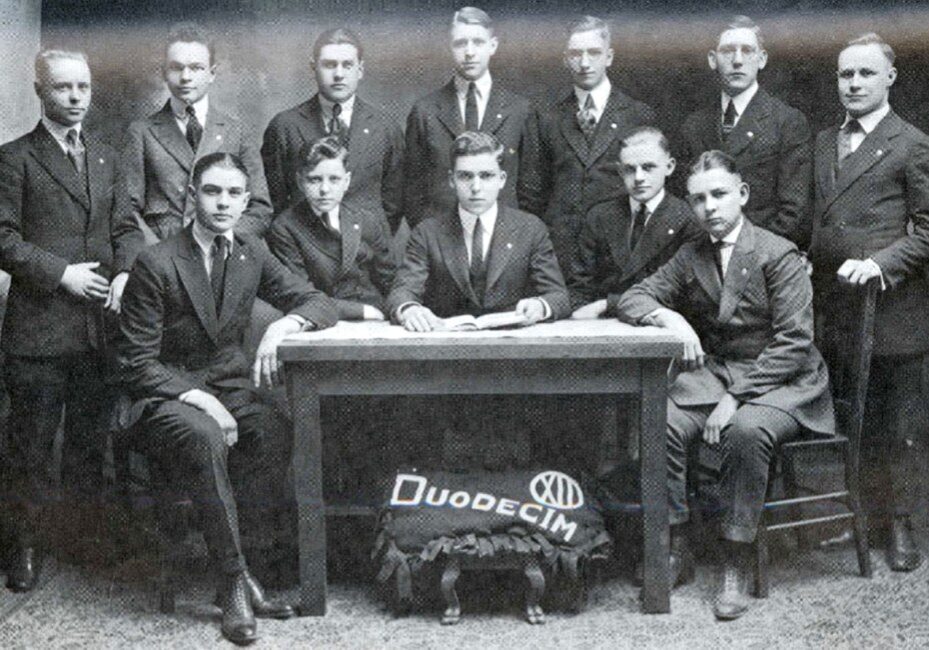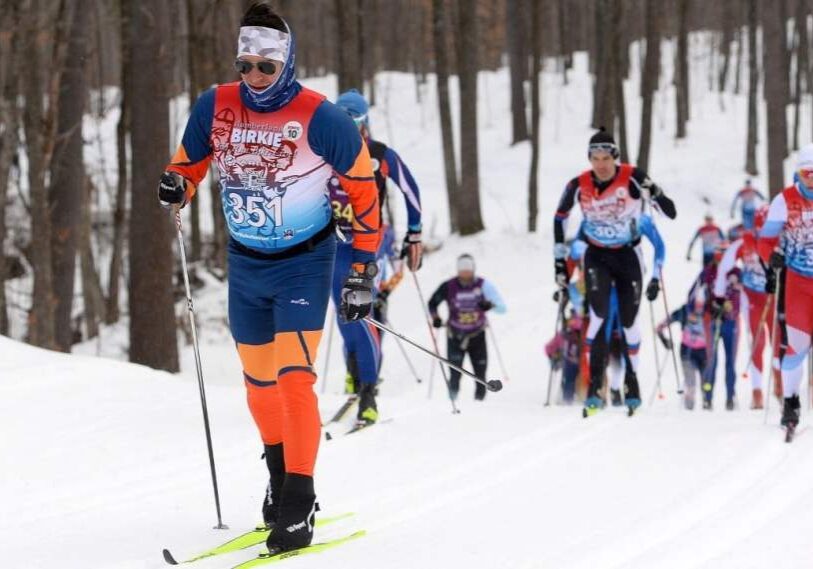Outdoor Adventures Abound at BaseCamp

WINONA — The crux of the first day of the three-day 2024 BaseCamp outdoor adventure weekend came in the final moments of the last event.
On the evening of August 16, youths and adults got to test-paddle canoes and kayaks; take a short educational hike through a river bottomland; and learn about the geological history of the Mississippi River and challenges facing it today.
The weekend concluded with Steven Marking interpreting the person and message of Will Dilg, a little known but massively important man who came up with the idea for the 100-year-old Upper Mississippi River National Wildlife and Fish Refuge.
At the very end of his talk, when not enough people were there to listen, he laid it out, “Now it is our turn, you must start the movement of restoration,” he said. “You must speak up for nature.”

Steve Marking portrays Will Dilg to tell the story of the Upper Mississippi and the formation of the Izaak Walton League. (Photo by John Weiss)
Marking had spent the previous half an hour telling of Dilg, a Chicago advertising executive, who loved to fly fish smallmouth bass on the river in this region. During one trip, his 2-year-old son fell off the houseboat and drowned. He and his wife turned their backs on the river, but not for long.
They came back.
Out of tragedy a lasting legacy
It was 1922 that Dilg and 53 others formed the Izaak Walton League of America that after a few years exploded with membership because people took to heart the Ike’s message: wetlands were being drained at a dangerous rate. Already 77 million acres were drained with government assistance and plans were on the table for millions of more acres, Marking said.
One plan, however, infuriated Dilg – to build dikes along the Mississippi River from below Lake Pepin to Rock Island, Illinois, and then drain the land behind them for cropland. That would forever mess up the river and its fishing.
As the story goes, it was in 1923 that he was feeling hopeless to stop the drainage juggernaut. It was when he was fishing around Wabasha that the idea hit him: “We’ll turn this whole cockeyed area into a game and fish refuge.”
Never mind that something like that had never been done, never mind that Congressional members told him he was a fool, that he was pushing too hard and that his idea was crazy.
“Some said he was a visionary, some said he was a fanatic, and some said he was obsessed,” Marking said. No matter what folks thought of him, he was determined.
Dilg and the Ikes organized a massive letter-writing campaign (the first of its kind) and got hundreds of thousands of women to join the campaign. “If I could not fish with my son, at least maybe I could save this last stretch of river from being destroyed,” said Marking of Dilg’s thoughts.
On June 7, 1924, a century ago, President Calvin Coolidge signed the bill establishing the refuge.
The beginning of the Upper Miss 
It was the beginning of the Upper Miss, as it’s known today. “The refuge stretches 261 river miles from Wabasha, Minnesota, to Rock Island, Illinois, and protects more than 240,000 acres of Mississippi River floodplain,” according to the U.S. Fish and Wildlife Service (USFWS) that manages it.
“The refuge hosts more than 3.7 million annual visits for hunting, fishing, wildlife observations, and other recreation,” according to the USFWS. “The refuge is a Wetland of International Importance and a Globally Important Bird Area.”
The key thing Dilg preached, outside of fishing smallmouth with a fly rod is an epitome of the fishing experience, was that man is not separate from nature. A crime against nature is a crime against mankind.
Now, new challenges face the Upper Miss and the entire Mississippi, Marking said. The monoculture farming of so much of the Upper Midwest is sending too much topsoil and deadly chemicals into the river.
Now it’s your turn, Marking-Dilg said.
Now it’s your turn to speak up for nature as he did more than a century ago.
The love of nature starts with doing
BaseCamp was a beginning because it did the first thing usually needed — getting people out on the river, to find a thing to love about it and then take the next step of protecting it.
The event was started several years ago by Sanborn Canoe Co. of Winona, said Adam Carlson, sales manager. The company makes canoes with composite hull and wood ribs in many lengths and designs.

A theme of the BaseCamp event shown in this poster. (Photo by John Weiss)
BaseCamp began as a block party at the canoe shop and had outdoor grilling and other niceties. “Over the years, it’s evolved to more of an outdoor recreational festival,” he said.
It’s billed as an “invitation to the outdoors” and as a gateway to the river.
Three children who accepted the invitation and kayaked in a backwater below the nearby spillway were Brady Thill, 9, Josie Swing, 10, and Harper Hines, 10, all of Galesville, Wis.
Brady’s mom, Nicole Thill, said the three are members of five Galesville families that camp there annually and they “happened to find out about this.” They tried it last year and the children loved it. “We don’t get to do it often,” she said.
At times, parents complain that they have to force children to get outdoors and play. Not these three.
“They wanted to (paddle), they begged us to,” she said. They like kayaks because they are by themselves.
Josie agreed. “It was fun, we were waiting for it all day.”
“We love being out on the water a lot in actual big boats,” Harper said. “They won’t let us drive them.”
What she also likes, besides paddling her own boat, is big boats coming by kicking up big waves so they can bob up and down. “I like going against big waves,” she said.
Soon after, Larry Kleiboer and his grandson, Ethan Kleiboer, 6, both of Winona, paddled a canoe. “You don’t have to drag that boy anywhere,” grandpa said.

Larry Kleiboer and his grandson, Ethan Kleiboer, 6, both of Winona, paddle a canoe they were testing at BaseCamp. (Photo by John Weiss)
“I just wanted to go out,” the boy said.
“We saw some turtles,” the grandson said. Eagles too, said grandpa.
An Ikes Celebration Too
Barry Drazkowski, president of the Winona-area Ikes, was also there in part to celebrate the centennial. The Ikes and staff of Upper Miss were wondering what events they could have for the 100th anniversary.
They planned for a one-day river film festival but when they talked with BaseCamp, they found they could work together. The June event was stopped by a rare summer flood. They decided on the August event, adding the conservation side to BaseCamp, including showing how Ikes test water for chemicals and underwater bugs.
Besides helping with the centennial, it was also a project for the Recreation Alliance, a Winona group promoting outdoors recreation, he said. He wasn’t disappointed with the small Friday turnout in part because of rain in the area. “The first time, it’s never going to be as big.”

Ann Conway, with the Prairie Island Campground in Winona, explains about the geological history of the Upper Mississippi River at the BaseCamp event in August. (Photo by John Weiss)
Ann Conway, co-manager of the campground, was there with a booklet helping people understand that the river valley has changed dramatically over the centuries.
The valley slowly began filling in after the second-to-last glacier pushed across northern North America and there wasn’t much river water at the glacier’s peak. But when it began to melt, the river was a monster, hundreds of feet higher than today, that swept away much of the past debris, so the valley was a few hundred feet lower than it is today.
What really changed the river, however, was European settlement, she said. They cleared many of the trees along and atop the bluffs or plowed prairie for farmland. And in the 1930s, turned the free-flowing river into a series of pools, each at least 9-feet deep for towboats to push barges up and downriver.

Ann Conway and Barry Drazkowski of Winona discuss a tree growing in the Mississippi River lowlands in Winona.
That dramatically changed the river. “We disturbed this landscape,” she said. “Our forest structure is changing.”
Take for example the island across from the campground. It was stable for centuries but now the “whole upper end is dying.”
The problem is the trees aren’t used to all the floods, said Jeff Butler, a forest ecologist with the National Audubon Society. The trees evolved to tolerate some wet times but not so many and for so long.
He received about $2 million for five years to restore river forests on the Minnesota side from the Minnesota Legacy Fund, coming from a surcharge on the state sales tax, he said. They also restore forests on the uplands because migrating birds (the Mississippi Flyway is the most-used of the continent’s four flyways) also use the uplands, he said.
So far, he said, he’s contracted to have more than 150,000 trees planted.
“I’m looking to plant trees that will be the future forest of tomorrow,” he said. “There is not enough natural tree reproduction happening on its own.”
Also, as trees die and the islands open up, there is a tendency to become overgrown with reed canary grass. “It’s a very difficult spot to be a tree and grow in that reed canary grass,” he said. A tree has to be 4- to 5-feet tall before it can grow.
About 80 percent of the trees are now silver maple that began growing when the locks-and-dams system was finished in the 1930s, Butler said. Now, he’s looking for more diversity, paying companies to plant swamp white oak that tolerates floodwaters, as well as willow, cottonwood and river birch that also are more flood tolerant.
He will also plant oaks in a stand of willows that grow fast and deer will eat the willow and not the oak so the oak has a chance to grow, he said.
Watching the Marking/Dilg presentation was Roger Berg, a member of the board of directors of the Win-Cres Chapter of Trout Unlimited (TU) that centers around the area. Trout Unlimited would have three members there the next day to demonstrate how to cast fly rods. That, in turn, would give them a chance to talk about TU’s mission of helping cold water streams.
“We’re trying to bring younger people into the organization,” Berg said. “Most of us are getting up in age now.”
It was the TU mission, however, that was key, that would let them, as Marking/Dilg said, speak up for nature. “We are beyond just fishing,” he said. “We are about fishing habitat and that involves water quality and water quality affects everybody.”
To learn more, watch this video trailer of Steven Marking’s “A Visit from Will Dilg” Recommended Root River Current articles that complement this story: Upper Mississippi National Wildlife Refuge Turns 100 Bringing Back Mississippi River Floodplain Forests The Mighty Mississippi’s Locks & Dams—What and Why? Other Mississippi River-related stories: Autumn Tundra Swan Migration Along the Mississippi






